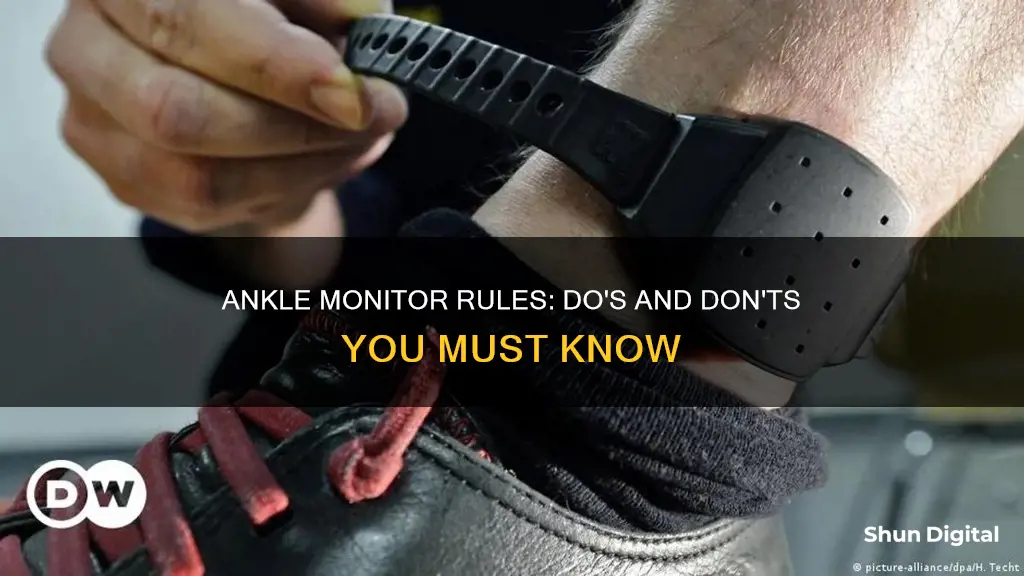
Ankle monitors are often used as an alternative to incarceration, with the court ordering individuals to wear them when they are on house arrest, probation or parole. They are also used to monitor alcohol consumption, with the device analysing sweat to determine whether it contains alcohol. The rules for wearing an ankle monitor include staying within a certain radius of your home, keeping a job, meeting with a probation or parole officer at scheduled times, paying court fees, and abstaining from drugs and alcohol. If you try to remove or damage the device, it will automatically send a signal to law enforcement.
| Characteristics | Values |
|---|---|
| Purpose | To ensure the wearer doesn't get into more trouble, to act as an alternative to jail time, or to reduce bail |
| Who wears them | People awaiting trial, people deemed a danger to the community or a flight risk, people on parole or house arrest, repeat offenders, people convicted of serious alcohol-related offenses, people awaiting immigration proceedings |
| Cost | The wearer may be forced to pay for the device and its installation themselves |
| Installation | A company will usually install the device |
| Alcohol monitoring | Secure Continuous Remote Alcohol Monitoring (SCRAM) bracelets can detect alcohol in a person's sweat |
| Movement restrictions | The wearer may be restricted to their home address, or allowed to travel to work, religious services, parole meetings, court hearings, medical services, and rehabilitation services |
| Alert system | If the wearer leaves the designated area, the device vibrates and emits a loud tone, and sends an alert to the authorities |
| Charging | The wearer is responsible for charging the device |
| Removal | The device cannot be removed until the court-approved date |
| Tampering | The device will send a signal to the relevant authorities if the wearer tampers with it or attempts to remove it |
What You'll Learn

Ankle monitors are used for those on house arrest or probation
Ankle monitors are often used as an alternative to incarceration, allowing people to remain in their community and avoid serving time in jail. They are typically worn by people on house arrest, probation, or parole. Here are some of the rules and restrictions associated with ankle monitors:
Rules for Ankle Monitors:
- Ankle monitors are court-ordered and must be worn at all times. They cannot be removed until a specified court date.
- The device tracks the wearer's location 24 hours a day and may include a curfew or specific boundaries that the wearer must stay within.
- Wearers must typically meet with their probation or parole officer at scheduled times and comply with all conditions of their supervision.
- They are often required to pay all court fees and may also have to pay for the ankle monitor's installation and monitoring fees.
- Abstaining from drugs and alcohol is usually a condition of wearing an ankle monitor.
- Ankle monitors are designed to be tamper-resistant, and any attempt to remove or damage the device will result in a signal being sent to law enforcement.
Ankle Monitors for House Arrest:
- House arrest is often used as an alternative to incarceration for people charged with minor crimes or as a way to reduce prison overcrowding.
- Ankle monitors for house arrest typically use GPS or a combination of GPS and WiFi to track an individual's location.
- A judge, probation officer, or parole officer may set a range that determines how far the individual can move. If they go beyond this range, the monitor sends a signal to the appointed officer.
- House arrest may include restrictions on movement, such as only being allowed to go to work, medical appointments, or other pre-approved locations.
Ankle Monitors for Probation:
- Ankle monitors are often used as a condition of probation or as an alternative to pre-trial detention.
- They can be used to monitor compliance with court orders, such as refraining from alcohol or maintaining a certain distance from a victim in cases of domestic violence.
- Probation ankle monitors can also be used to track alcohol consumption by testing the wearer's sweat and relaying this information to the authorities.
- Violating the terms of probation, such as consuming alcohol or going beyond the allowed range, may result in additional penalties, including jail time.
In conclusion, ankle monitors are used as a form of surveillance to track an individual's location and ensure compliance with court-ordered restrictions. They are often seen as a preferable alternative to incarceration, allowing people to remain in their community and avoid jail time. However, critics argue that ankle monitors can be restrictive and hinder individuals' ability to rebuild their lives after prison.
Blind Spot Monitoring: Is It Available on the VW Alltrack?
You may want to see also

They can be used to detect alcohol consumption
Ankle monitors, also known as SCRAM bracelets, can be used to detect alcohol consumption. SCRAM stands for Secure Continuous Remote Alcohol Monitoring. These devices are typically worn by individuals who have been convicted of alcohol-related offences, such as driving under the influence (DUI) or driving while intoxicated (DWI). They are often used as an alternative to incarceration or pre-trial detention, or as a condition of probation or parole.
The SCRAM bracelet is fitted to the individual's ankle and tests for the presence of alcohol in their perspiration or sweat. This is known as transdermal alcohol testing. The bracelet takes samples of the wearer's perspiration every 30 minutes to an hour, measuring the transdermal alcohol concentration. This allows the device to create a detailed profile of the wearer's alcohol consumption patterns over a specific period, which can be used in legal settings.
The data collected by the SCRAM bracelet is transmitted to a base station or a regional monitoring centre. If the wearer's sweat contains alcohol, or if there are any signs of tampering, the authorities are notified. This allows for the enforcement of court orders restricting alcohol consumption and helps to prevent reoffending.
In addition to alcohol monitoring, SCRAM bracelets may also track the wearer's location using GPS technology or radio frequency signals. This dual functionality ensures that individuals with alcohol-related offences comply with movement restrictions and stay within designated boundaries.
The use of SCRAM bracelets offers several benefits. Firstly, it supports long-term behaviour change and complements treatment for alcohol dependence or addiction. It encourages sobriety and increases compliance with court orders, thereby enhancing community safety. Secondly, it eliminates the need for frequent in-person check-ins and alcohol tests, reducing the burden on both the individual and the authorities.
It is important to note that SCRAM bracelets may not always be completely accurate. False positives can occur due to the use of alcohol-based products, such as mouthwash. Additionally, while the bracelets can detect low alcohol consumption (1-2 units), they cannot confirm complete abstinence from alcohol.
Unlocking ASUS Monitor Key Lock: A Step-by-Step Guide
You may want to see also

They are a cheaper alternative to incarceration
Ankle monitors are often regarded as a cheaper alternative to incarceration. They are used to track individuals who are under the supervision of the criminal justice system and are worn by those on probation or parole, or those awaiting trial. They are also used for individuals convicted of a crime but deemed low-risk and not considered a danger to the community.
Ankle monitors are less expensive than keeping someone in jail or prison, and they allow individuals to maintain their jobs and support their families. This can make it easier for them to reintegrate into society once their sentences are completed.
However, ankle monitors are not without their disadvantages. They can be uncomfortable and cause skin irritation. Individuals wearing them are subject to strict rules and regulations, and any violation can result in additional penalties or even imprisonment.
While ankle monitors can be a viable option for some, it is important to use them with discretion. They are not a replacement for traditional imprisonment but rather a complement to it. The nature of the crime and the offender's risk of reoffending must be considered when deciding whether to use an ankle monitor.
Alcohol Ankle Monitors: Can They Detect Drugs Too?
You may want to see also

They can be used to enforce curfews
Ankle monitors are often used to enforce curfews. They are usually employed by law enforcement as a surveillance tool, serving as a tether to the justice system for individuals on parole or house arrest. Ankle monitors can be used to ensure that the wearer stays within a set boundary or curfew. This is achieved through the use of GPS technology or radio frequency, which transmits location data to a monitoring centre.
Radio Frequency (RF) monitors are typically used for enforcing curfews and house arrest cases. They notify the monitoring centre when the device comes into or departs from a designated area. These monitors do not give an exact location but instead inform the centre about the device's general whereabouts in relation to the home-based unit. The home unit will detect the bracelet if it is within 50 to 150 feet.
Global Positioning System (GPS) ankle monitors, on the other hand, provide specific geographical coordinates and can be very precise. They are often used to allow individuals to travel according to pre-arranged schedules, such as travelling to and from work, attending religious services, or going to medical appointments.
In addition to monitoring location, ankle monitors can also be used to detect alcohol consumption. This is done by analysing the wearer's sweat to determine if it contains alcohol. This feature is particularly important for enforcing restrictions on individuals with alcohol-related offences, such as driving under the influence.
The use of ankle monitors allows for ongoing and accurate monitoring, with some units notifying authorities if the wearer attempts to remove or tamper with the device. This helps to maintain public safety while also providing offenders with a degree of controlled freedom.
Monitor Size for Developers: How Big is Too Big?
You may want to see also

They are a deterrent to repeat offending
Ankle monitors are a useful tool for law enforcement to ensure compliance with court-ordered movement restrictions. They are often used as an alternative to harsher penalties, such as incarceration, and can help deter repeat offending in several ways. Firstly, they provide a physical reminder of the consequences of reoffending. The presence of the monitor serves as a constant visual and physical reminder to the wearer of the restrictions imposed on them and the potential penalties for violating those restrictions. This can act as a psychological deterrent to repeat offending, as the wearer is constantly aware of the consequences of their actions.
Secondly, ankle monitors with GPS technology can track the wearer's location and alert authorities if they enter restricted areas or come near off-limits locations. This helps create a "digital fence" that discourages repeat offending by making it difficult for the wearer to return to the scene of their previous crime or enter areas where they are likely to reoffend. It also enables authorities to quickly respond to any potential incidents, reducing the likelihood of successful reoffending.
Additionally, ankle monitors can be equipped with alcohol-detecting technology, which tests the wearer's sweat for alcohol content. This feature is particularly useful for enforcing restrictions on individuals with alcohol-related offenses, such as driving under the influence (DUI). By monitoring sobriety, these ankle monitors can help deter repeat offending by individuals with substance abuse issues, providing an opportunity for rehabilitation without the need for incarceration.
Furthermore, the cost of the ankle monitor and associated fees can serve as a financial deterrent to repeat offending. In some cases, the wearer may be required to pay for the device and monitoring services themselves, which can amount to hundreds of dollars per month. The financial burden of these costs can motivate individuals to comply with the terms of their sentence and avoid reoffending, as further criminal charges could result in additional financial penalties or incarceration.
Hooking Up TV Monitor Audio: A Simple Guide
You may want to see also
Frequently asked questions
An ankle monitor is a device worn around the ankle that tracks the wearer's location and movement. It is usually locked in place to allow for ongoing, accurate monitoring and can be removed only on the court-approved date.
The rules for wearing an ankle monitor vary on a case-by-case basis. However, some common rules include:
- Meeting with a probation or parole officer at scheduled times
- Paying all court fees
- Abstaining from drugs and alcohol
- Complying with all conditions of supervision
- Not tampering with or attempting to remove the device
Violating the rules of an ankle monitor can result in serious consequences, including arrest and jail time. The judge may also impose stricter monitoring terms or revoke parole.
The cost of wearing an ankle monitor typically includes a set-up fee and a daily use fee. The set-up fee can range from $175 to $200, while the daily fee can be between $5 and $40.







